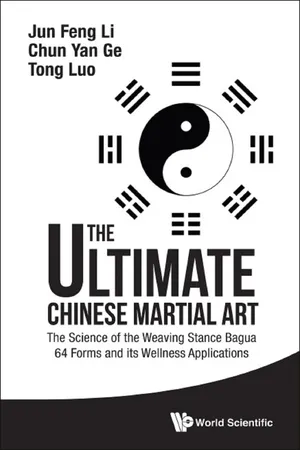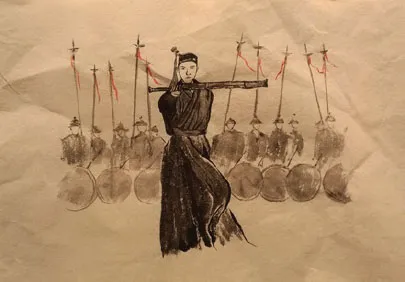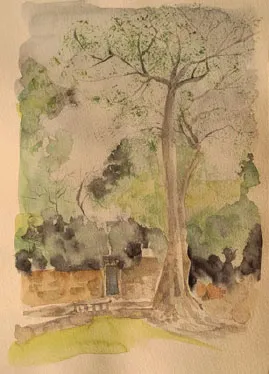![]()
|
| | Part I: History and Philosophy of Chinese Martial Arts |
Nowadays, many people think of Chinese martial arts as being similar to dancing or gymnastics. If you watch many Chinese martial art competitions, it does appear to be so. However, the origins of Chinese martial art were more somber, being essentially for killing. It was no game. It was not even a sport.
Martial arts is not about jumping high or low, running fast or slow, being strong or weak, winning or losing, earning respect or contempt. Honor, pain, tears, and blood — all these are irrelevant to a Chinese gongfu master.
Chinese martial arts are arts of survival. They are only about life or death, nothing else.
In fact, if you really want to live, you cannot even afford to care too much about living or dying. Thinking too much about anything in a fight can only cost you your life.
Death can arrive at any point in time. Once it arrives, it cannot be undone, not like a computer game. That is why occasionally, a martial artist can look a bit too serious.
This is the style of a real Chinese martial artist — ultimately unstoppable. In this sense, the Chinese martial art seems not much different from martial arts of other countries.
However, like all other martial arts from elsewhere in the world, Chinese martial arts have a unique approach influenced by local culture. The most important aspects of local culture for the Chinese are Taoism and Confucianism.
![]()
| 1 Taoism and Confucianism: Two Major Pillars of Chinese Rationalism |
It might seem strange to talk about an ancient Chinese religion at the very beginning of a martial arts book. The reason is both simple and complicated.
The simple part is the form we introduce in this book: Bagua, a Taoism-styled martial art. Actually, Bagua is the most thorough Taoism martial art that has ever appeared. From its name to its very core theory, it is all about Taoism.
The more complicated part is, Taoism is the root of all elements in typical Chinese culture, and that includes the Chinese martial arts as a whole, not just Bagua. Only with decent knowledge about Taoism can we understand the origin of Chinese martial arts.
At the same time, as a long-time “official” philosophy in China, Confucianism has such a vast influence on all aspects of Chinese culture and on many different trades, that we cannot talk about anything Chinese without a good understanding of Confucianism. In many cases, Confucianism and Taoism have mixed influences on trades such as calligraphy, painting, and even the Chinese medical system. Through Taoism and Confucianism, we also find connections of Chinese martial arts to all those trades.
Through studying the connections of Chinese martial arts to all the other seemingly irrelevant trades, we can gain a deeper understanding of the Chinese martial arts themselves. At the same time, such an understanding will enable us to find applications of what we learn from Chinese martial arts to all other aspects of our daily life.
The whole system is just like a tree. If the real martial art part is the trunk, Taoism and Confucianism are both its roots and branches. You do not want to paint a tree with only a trunk (Fig. 1.1).
This is also the learning style of a Chinese martial artist: to connect whatever you have learned from other subjects to martial arts and apply whatever you have learned in martial arts to all aspects of your daily life.
Simply put, if learning Chinese martial arts has not made you a better chef, driver, manager, banker, actor, singer, or calligrapher, you have not learned anything about Chinese martial arts.
Later we will explain further why this makes sense.
History of Taoism
In China, no religion has ever shown any dominance in normal people’s daily lives. To be accurate, there has been actually no religion in China at all by western standards.
Very different from the situation in western society, people who devote themselves 100% to any religion are regarded by the Chinese as marginal people in society. People in China treat them as we treated gay people 20 years ago, largely because they have one thing in common: they do not reproduce.
This was also the case with the upper-class Chinese: Culturally, both Buddhism and Taoism have had an extensive influence on them, but more as a philosophical nutrition to their minds than as a placebo to their hearts.
The word
Tao (
), which literally means
way, came from the word
Dao (
), which means
to step on. In the early days of Chinese culture, all sorts of people called the methods of their trades
Tao. The warriors called their methods
Wu Tao (
the way of martial arts). The doctors called their trade
Yi Tao (
, the way of medical arts), etc.
Then why did only the Taoists in later years dominate the word Tao and call themselves Taoists? There is a reason for that. From the very beginning, Zhuang-zi (
) claimed that all the other trades are subjects with a different specific focus, while only Taoism covers the core wisdom of all those trades. It is like a wisdom about wisdom, which makes it a perfect match to philosophy rather than religion.
Buddhism was imported at a much later time, so Taoism as a home-grown “religion” had been virtually the only influential religion for a long time. As a home-grown religion, the Taoism approach represents the way Chinese interpret the world around them. Chinese martial arts are no exception. This is the major reason why we start from Taoism when we discuss Chinese martial arts.
At the same time, the Taoists, together with all other religious people in China, were regarded as
, which means people not involved in worldly affairs such as reproducing themselves. They had a much bigger degree of freedom to do whatever they wanted to. They also typically had more time to practice as they did not have social burdens, such as a family to support. So it is no surprise that many great fighters were Taoists or Buddhist monks, such as the legendary Wudang Clan and Shaolin monks.
Taoism was not a religion when Lao-zi and Zhuang-zi set the foundation of Taoism over 2000 years a...
















